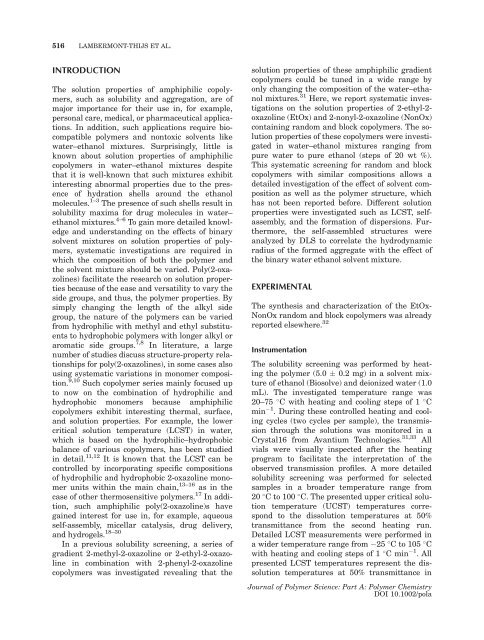Solubility behavior of amphiphilic block and random copolymers ...
Solubility behavior of amphiphilic block and random copolymers ...
Solubility behavior of amphiphilic block and random copolymers ...
Create successful ePaper yourself
Turn your PDF publications into a flip-book with our unique Google optimized e-Paper software.
516 LAMBERMONT-THIJS ET AL.<br />
INTRODUCTION<br />
The solution properties <strong>of</strong> <strong>amphiphilic</strong> <strong>copolymers</strong>,<br />
such as solubility <strong>and</strong> aggregation, are <strong>of</strong><br />
major importance for their use in, for example,<br />
personal care, medical, or pharmaceutical applications.<br />
In addition, such applications require biocompatible<br />
polymers <strong>and</strong> nontoxic solvents like<br />
water–ethanol mixtures. Surprisingly, little is<br />
known about solution properties <strong>of</strong> <strong>amphiphilic</strong><br />
<strong>copolymers</strong> in water–ethanol mixtures despite<br />
that it is well-known that such mixtures exhibit<br />
interesting abnormal properties due to the presence<br />
<strong>of</strong> hydration shells around the ethanol<br />
molecules. 1–3 Thepresence<strong>of</strong>suchshellsresultin<br />
solubility maxima for drug molecules in water–<br />
ethanol mixtures. 4–6 To gain more detailed knowledge<br />
<strong>and</strong> underst<strong>and</strong>ing on the effects <strong>of</strong> binary<br />
solvent mixtures on solution properties <strong>of</strong> polymers,<br />
systematic investigations are required in<br />
which the composition <strong>of</strong> both the polymer <strong>and</strong><br />
the solvent mixture should be varied. Poly(2-oxazolines)<br />
facilitate the research on solution properties<br />
because <strong>of</strong> the ease <strong>and</strong> versatility to vary the<br />
side groups, <strong>and</strong> thus, the polymer properties. By<br />
simply changing the length <strong>of</strong> the alkyl side<br />
group, the nature <strong>of</strong> the polymers can be varied<br />
from hydrophilic with methyl <strong>and</strong> ethyl substituents<br />
to hydrophobic polymers with longer alkyl or<br />
aromatic side groups. 7,8 In literature, a large<br />
number <strong>of</strong> studies discuss structure-property relationships<br />
for poly(2-oxazolines), in some cases also<br />
using systematic variations in monomer composition.<br />
9,10 Such copolymer series mainly focused up<br />
to now on the combination <strong>of</strong> hydrophilic <strong>and</strong><br />
hydrophobic monomers because <strong>amphiphilic</strong><br />
<strong>copolymers</strong> exhibit interesting thermal, surface,<br />
<strong>and</strong> solution properties. For example, the lower<br />
critical solution temperature (LCST) in water,<br />
which is based on the hydrophilic–hydrophobic<br />
balance <strong>of</strong> various <strong>copolymers</strong>, has been studied<br />
in detail. 11,12 It is known that the LCST can be<br />
controlled by incorporating specific compositions<br />
<strong>of</strong> hydrophilic <strong>and</strong> hydrophobic 2-oxazoline monomer<br />
units within the main chain, 13–16 as in the<br />
case <strong>of</strong> other thermosensitive polymers. 17 In addition,<br />
such <strong>amphiphilic</strong> poly(2-oxazoline)s have<br />
gained interest for use in, for example, aqueous<br />
self-assembly, micellar catalysis, drug delivery,<br />
<strong>and</strong> hydrogels. 18–30<br />
In a previous solubility screening, a series <strong>of</strong><br />
gradient 2-methyl-2-oxazoline or 2-ethyl-2-oxazoline<br />
in combination with 2-phenyl-2-oxazoline<br />
<strong>copolymers</strong> was investigated revealing that the<br />
solution properties <strong>of</strong> these <strong>amphiphilic</strong> gradient<br />
<strong>copolymers</strong> could be tuned in a wide range by<br />
only changing the composition <strong>of</strong> the water–ethanol<br />
mixtures. 31 Here,wereportsystematicinvestigations<br />
on the solution properties <strong>of</strong> 2-ethyl-2-<br />
oxazoline (EtOx) <strong>and</strong> 2-nonyl-2-oxazoline (NonOx)<br />
containing r<strong>and</strong>om <strong>and</strong> <strong>block</strong> <strong>copolymers</strong>. The solution<br />
properties <strong>of</strong> these <strong>copolymers</strong> were investigated<br />
in water–ethanol mixtures ranging from<br />
pure water to pure ethanol (steps <strong>of</strong> 20 wt %).<br />
This systematic screening for r<strong>and</strong>om <strong>and</strong> <strong>block</strong><br />
<strong>copolymers</strong> with similar compositions allows a<br />
detailed investigation <strong>of</strong> the effect <strong>of</strong> solvent composition<br />
as well as the polymer structure, which<br />
has not been reported before. Different solution<br />
properties were investigated such as LCST, selfassembly,<br />
<strong>and</strong> the formation <strong>of</strong> dispersions. Furthermore,<br />
the self-assembled structures were<br />
analyzed by DLS to correlate the hydrodynamic<br />
radius <strong>of</strong> the formed aggregate with the effect <strong>of</strong><br />
the binary water ethanol solvent mixture.<br />
EXPERIMENTAL<br />
The synthesis <strong>and</strong> characterization <strong>of</strong> the EtOx-<br />
NonOx r<strong>and</strong>om <strong>and</strong> <strong>block</strong> <strong>copolymers</strong> was already<br />
reported elsewhere. 32<br />
Instrumentation<br />
The solubility screening was performed by heating<br />
the polymer (5.0 0.2 mg) in a solvent mixture<br />
<strong>of</strong> ethanol (Biosolve) <strong>and</strong> deionized water (1.0<br />
mL). The investigated temperature range was<br />
20–75 C with heating <strong>and</strong> cooling steps <strong>of</strong> 1 C<br />
min 1 . During these controlled heating <strong>and</strong> cooling<br />
cycles (two cycles per sample), the transmission<br />
through the solutions was monitored in a<br />
Crystal16 from Avantium Technologies. 31,33 All<br />
vials were visually inspected after the heating<br />
program to facilitate the interpretation <strong>of</strong> the<br />
observed transmission pr<strong>of</strong>iles. A more detailed<br />
solubility screening was performed for selected<br />
samples in a broader temperature range from<br />
20 Cto100 C. The presented upper critical solution<br />
temperature (UCST) temperatures correspond<br />
to the dissolution temperatures at 50%<br />
transmittance from the second heating run.<br />
Detailed LCST measurements were performed in<br />
a wider temperature range from 25 Cto105 C<br />
with heating <strong>and</strong> cooling steps <strong>of</strong> 1 Cmin 1 .All<br />
presented LCST temperatures represent the dissolution<br />
temperatures at 50% transmittance in<br />
Journal <strong>of</strong> Polymer Science: Part A: Polymer Chemistry<br />
DOI 10.1002/pola
















